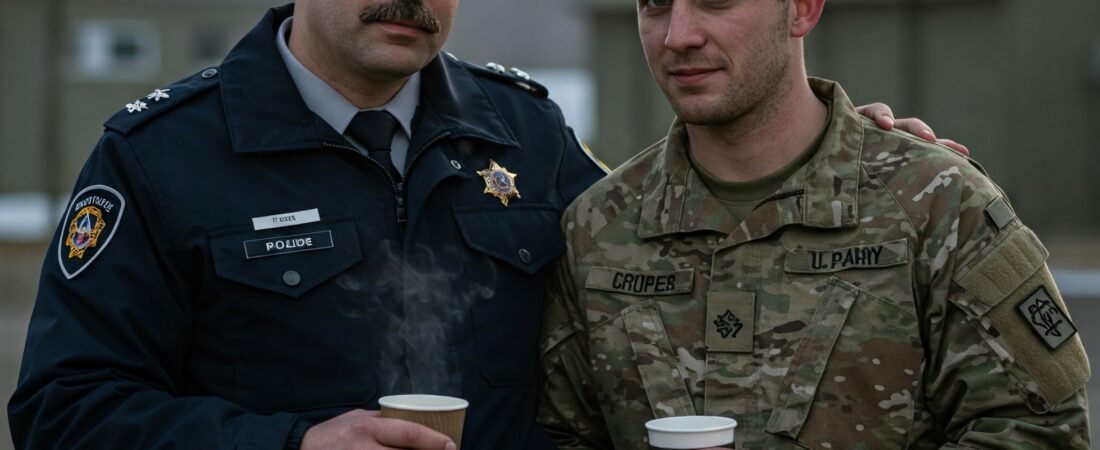The phrase “Red vs. Blue” evokes immediate associations. For many, it’s the classic setup of a video game, a simple way to divide teams. But dig a little deeper, and this fundamental color contrast carries significant weight in fields where the stakes are life and death: law enforcement and the military. It represents everything from ethical tightropes to strategic simulations and the very physics of visibility.
The Thin Blue Line: Cops vs. Robbers
In law enforcement, “Blue” is iconic. It symbolizes the “thin blue line” – the police force standing as the barrier between order and chaos, protecting society from criminality. They are the designated upholders of the law, the force for stability.
But where does “Red” fit in? It’s less about a literal color and more about the opposition – the actions that cross the line into illegality, harm, and disorder. The “robber” in this context isn’t just someone who steals; it’s a stand-in for anyone operating outside or against the law.
The truly complex part is the fine line between these two. Law enforcement officers operate under immense pressure, granted significant authority (including the use of force), and often delve into the darkest parts of human behaviour. To be effective, they sometimes need to think like those they pursue. This proximity creates a dangerous edge:
- Ethical Slippage: The constant exposure to crime and the power imbalance can, for some, lead to corruption, excessive force, or bending the rules – blurring the line between enforcing the law and breaking it. Actions intended to catch the “robber” can sometimes mirror the robber’s disregard for rules.
- Us vs. Them Mentality: The strong camaraderie (“Blue family”) is vital for support but can sometimes foster an isolating mentality that views the public, or certain segments of it, with suspicion, potentially eroding trust.
- Maintaining Trust: The legitimacy of law enforcement hinges on public trust. When officers cross the line – when “Blue” acts “Red” – that trust is damaged, making the job harder for everyone and undermining the very order they’re meant to protect.
Being “Blue” isn’t just wearing the uniform; it’s a constant ethical struggle to wield authority responsibly and stay firmly on the side of the law, avoiding the actions and mindset of those they oppose.
Red vs. Blue in Military Simulation
In the military, “Red vs. Blue” takes on a much more defined, strategic meaning. It’s the standard terminology for opposing sides in training exercises and wargames:
- Blue Force (BLUFOR): Represents friendly forces (your own military, allies).
- Red Force (REDFOR) / Opposing Force (OPFOR): Represents the adversary or potential enemy forces.
Here, the distinction is clear-cut and essential for effective training. REDFOR units often study and replicate the tactics, equipment, and doctrine of potential real-world adversaries. The purpose isn’t an ethical struggle, but a practical one:
- Testing Tactics: Pitting Blue tactics against a thinking, adapting Red enemy reveals weaknesses and validates strengths.
- Improving Readiness: Simulating combat scenarios prepares troops for the complexities of actual warfare.
- Understanding the Enemy: Forcing Blue commanders to react to realistic enemy actions (as simulated by REDFOR) improves strategic thinking.
Unlike the internal, ethical “Red vs. Blue” tension in law enforcement, the military use is about external opposition in a controlled, simulated environment.
Military Implications of ROY G. BIV
Beyond the simple Red/Blue dichotomy, the entire visible light spectrum (ROY G. BIV – Red, Orange, Yellow, Green, Blue, Indigo, Violet) and even wavelengths beyond it play critical roles in military operations:
- Identification: While camouflage aims to blend in, specific colors are still used for identification. Think national flags (though often subdued in combat), specific patches, or colored smoke/flares for signaling location or status (e.g., green for safe passage, red for danger/enemy contact). Identification Friend or Foe (IFF) systems often use non-visible parts of the spectrum (like infrared strobes).
- Visibility & Technology:
- Night Vision: Green is often chosen for NVGs because the human eye is sensitive to green, allowing for subtle shade differentiation, and it was historically efficient for the phosphors used.
- Light Discipline: Red light is commonly used when preserving night vision (e.g., map reading) because it least affects the rods in the eyes responsible for low-light sight.
- Lasers: Targeting and aiming lasers often use Red or Green visible light, while laser rangefinders or designators might use infrared (invisible) light.
- Thermal Imaging: Detects heat signatures, often displaying them in a color gradient (which can include reds, yellows, blues) unrelated to the object’s actual visible color.
- Camouflage: Effective camouflage relies on using colors (often greens, browns, tans – parts of the spectrum) and patterns that match the operational environment, breaking up shapes and blending with surroundings across different light conditions.
From the stark opposition in training simulations to the subtle physics of light used in advanced technology and basic signaling, color – the whole spectrum represented by ROY G. BIV – is woven into the fabric of military strategy and tactics.
Conclusion
“Red vs. Blue” is more than just team colors. In law enforcement, it highlights the critical, often precarious, ethical line between upholding order and falling into misconduct. In the military, it’s a fundamental tool for simulating conflict and preparing forces. And broadening the view to the full spectrum reminds us how deeply color, light, and visibility influence identification, technology, and survival in high-stakes environments. Whether representing an ethical choice or a strategic opponent, the contrast between Red and Blue underscores fundamental aspects of conflict, control, and perception.
